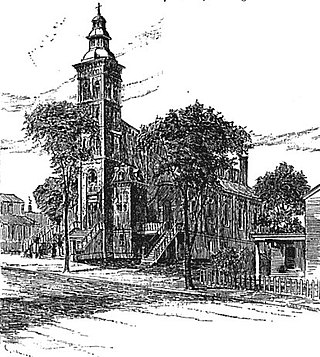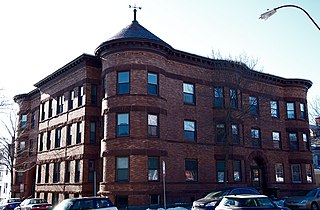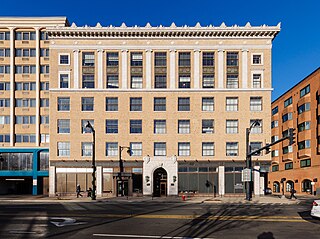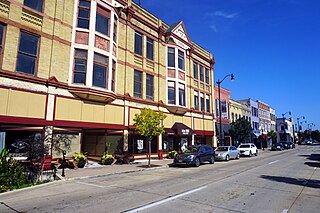
The Windsor Avenue Congregational Church is a historic church at 2030 Main Street in Hartford, Connecticut. The brick Romanesque Revival-style church building, completed in 1872, now houses Faith Congregational Church, whose lineage includes the city's oldest African-American congregation, established in 1819. The church is a stop on the Connecticut Freedom Trail and was listed on the United States National Register of Historic Places in 1993.

The First Universalist Church is a historic church building on the corner of Pleasant, Elm, and Spring Streets in Auburn, Maine. It was built in 1876 to a design by John Stevens of Boston, Massachusetts, and has been a significant landmark in the city since its construction. It is a fine local example of Gothic Revival architecture executed in brick, and was listed on the National Register of Historic Places in 1979.

The Soul Harvest Ministries is located at 16300 Woodward Avenue in Highland Park, Michigan. It was built in 1916 as the First United Methodist Church and listed on the National Register of Historic Places in 1982.

The Park United Presbyterian Church is located at 14 Cortland Street in Highland Park, Michigan. It was built in 1910 as the Highland Park Presbyterian Church, listed on the National Register of Historic Places in 1982, and designated a Michigan State Historic Site in 1983. It is a member of The Presbyterian Church (U.S.A.), and continues to offer services.

Allston Congregational Church is a historic Congregational church building at 31-41 Quint Avenue in the Allston neighborhood Boston, Massachusetts. Built in 1890–91 to a design by Allston native Eugene L. Clark, it is a prominent local example of Richardsonian Romanesque architecture. The property includes a Shingle style parsonage built about the same time. The buildings were listed on the National Register of Historic Places in 1997. The building presently houses a mosque and the Palestinian Cultural Center for Peace.

The First Baptist Church is a historic American Baptist church at Magazine and River Street in Cambridge, Massachusetts within Central Square. In 1817 the church congregation was founded in the home of James Hovey. In 1844 several members of First Baptist Church left to found nearby Old Cambridge Baptist Church. First Baptist Church's current Gothic building was constructed in 1881 to a design by Hartwell and Richardson. It was added to the National Register of Historic Places in 1975.

St. John the Evangelist is a historic Roman Catholic Church at 2270 Massachusetts Avenue in Cambridge, Massachusetts.

The former First Unitarian Church is a historic church building at 130 Highland Avenue in Somerville, Massachusetts. The stone church was built in 1894 for a Unitarian congregation. It was designed by Hartwell & Richardson and is a good example of Richardsonian Romanesque design. The building presently (2022) houses the Mission Church of Our Lord Jesus Christ.

The Central Library is the main branch of the Somerville, Massachusetts, public library system. It is an architecturally distinguished Renaissance Revival brick building designed by Edward Lippincott Tilton and was built in 1914 with funding assistance from philanthropist Andrew Carnegie. The building was listed on the National Register of Historic Places in 1989.

St. Joseph's Church was an historic Roman Catholic church at Howard Street and East Columbus Avenue in Springfield, Massachusetts. Built in 1873-77, it was a brick Romanesque Revival structure with brownstone trim, and was a fine local example of the style. It was the city's first church to specifically serve its French Canadian immigrant and French American population. The building was listed on the National Register of Historic Places in 1983. It was demolished in 2008.

The Levi Heywood Memorial Library Building is an historic library building at 28 Pearl Street in Gardner, Massachusetts. Completed in 1886, it is one of the city's most architecturally distinguished buildings, and a good example of Richardsonian Romanesque design. It was given in honor of Levi Heywood, a prominent figure in the city's economically important chair manufacturing industry. It was used as a library until 1978, and now houses a museum dedicated to the city's history. The building was listed on the National Register of Historic Places in 1979, and included in the Gardner Uptown Historic District in 1999.

St. Charles Borromeo Church is a former parish of the Catholic Church in Waltham, Massachusetts. It is noted for its historic church building, completed in 1922. A high quality example of Italian Renaissance Revival architecture, it is emblematic of the shift on Waltham's south side from a predominantly Protestant population to one of greater diversity. The building was listed on the National Register of Historic Places in 1989.

The Highland is a historic multiunit residence at 66 Highland Avenue in Somerville, Massachusetts. The three-story brick building was built in 1892 to a design by architect Samuel D. Kelley. It is one of the city's more elegant late 19th-century apartment houses, built during its rapid expansion in the late 19th century. The building listed on the National Register of Historic Places in 1989.

St. Cecilia Church is a Roman Catholic parish church in the Roman Catholic Archdiocese of New York and a historic landmark located at 120 East 106th Street between Park Avenue and Lexington Avenue, Manhattan, New York City, New York. The parish was established in 1873. It was staffed by the Redemptorist Fathers from 1939 to 2007. The church was designated a New York City landmark in 1976. The church and convent were listed on the U.S. National Register of Historic Places in 1984.

United Baptist Church of Lakeport is a historic church at 35 Park Street in the village of Lakeport in Laconia, New Hampshire, United States. Built in 1891 after a fire destroyed an older church, it is an eclectic local example of Late Victorian architecture. It was listed on the National Register of Historic Places in 1985.

The Sts. Cyril and Methodius Church is a historic Roman Catholic church at 55 Charter Oak Avenue in Hartford, Connecticut. It is a large, two story brick structure with limestone trim, designed by Timothy G. O'Connell and built in 1914 to serve the city's growing Polish-American population. The interior in particular is decorated with symbols generally found in Catholic churches in Poland, including the Polish eagle. The church was listed on the National Register of Historic Places in 1983.

The High Street Historic District of Hartford, Connecticut is a 1.1-acre (0.45 ha) historic district that includes three buildings typifying the architectural styles of the late 19th and early 20th centuries in the city. It was listed on the National Register of Historic Places in 1998. The buildings are located at 402-418 Asylum Street, 28 High Street, and 175-189 Allyn Street, and includes the Batterson Block and Judd and Root Building, each individually listed for their architecture.

The First Congregational Church of Manistee, Michigan is a church located at 412 South 4th Street in Manistee, Michigan. It was listed on the National Register of Historic Places in 1974.

The Highland Avenue Methodist Church in Milwaukee, Wisconsin is a Gothic Revival-styled church built in 1891 by Milwaukee's first German Methodist congregation. It was added to the National Register of Historic Places in 1986.

The Historic Sixth Street Business District is a set of largely intact two and three-story shops along the main road coming into Racine, Wisconsin from the west. Most of the buildings were constructed from the 1850s to the 1950s. The district was added to the National Register of Historic Places in 1988.
























